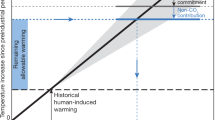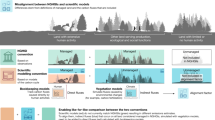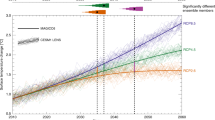Abstract
Recent estimates of the amount of carbon dioxide that can still be emitted while achieving the Paris Agreement temperature goals are larger than previously thought. One potential reason for these larger estimates may be the different temperature metrics used to estimate the observed global mean warming for the historical period, as they affect the size of the remaining carbon budget. Here we explain the reasons behind these remaining carbon budget increases, and discuss how methodological choices of the global mean temperature metric and the reference period influence estimates of the remaining carbon budget. We argue that the choice of the temperature metric should depend on the domain of application. For scientific estimates of total or remaining carbon budgets, globally averaged surface air temperature estimates should be used consistently for the past and the future. However, when used to inform the achievement of the Paris Agreement goal, a temperature metric consistent with the science that was underlying and directly informed the Paris Agreement should be applied. The resulting remaining carbon budgets should be calculated using the appropriate metric or adjusted to reflect these differences among temperature metrics. Transparency and understanding of the implications of such choices are crucial to providing useful information that can bridge the science–policy gap.
This is a preview of subscription content, access via your institution
Access options
Access Nature and 54 other Nature Portfolio journals
Get Nature+, our best-value online-access subscription
$29.99 / 30 days
cancel any time
Subscribe to this journal
Receive 12 print issues and online access
$259.00 per year
only $21.58 per issue
Buy this article
- Purchase on Springer Link
- Instant access to full article PDF
Prices may be subject to local taxes which are calculated during checkout



Similar content being viewed by others
Data availability
The Cowtan and Way32 GBST datasets with different SST reconstructions are available at: https://www-users.york.ac.uk/~kdc3/papers/coverage2013/. The HadCRUT4.6 data is available at: https://www.metoffice.gov.uk/hadobs/hadcrut4/. GISTEMPv4 is available at: https://data.giss.nasa.gov/gistemp/. COBE-SST2 and ERSSTv5 data is provided by the NOAA/OAR/ESRL PSD via https://www.esrl.noaa.gov/psd/data/gridded/. ERA-Interim is available at: https://www.ecmwf.int/en/forecasts/datasets/reanalysis-datasets/era-interim. MERRA2 was downloaded from: https://gmao.gsfc.nasa.gov/reanalysis/MERRA-2/. CMIP5 and CMIP6 model output is available at: http://pcmdi9.llnl.gov/. CESM1 pacemaker experiments are available at: https://www.earthsystemgrid.org/.
References
Zickfeld, K., Eby, M., Matthews, H. D. & Weaver, A. J. Setting cumulative emissions targets to reduce the risk of dangerous climate change. Proc. Natl Acad. Sci. USA 106, 16129–16134 (2009).
Matthews, H. D., Gillett, N. P., Stott, P. A. & Zickfeld, K. The proportionality of global warming to cumulative carbon emissions. Nature 459, 829–832 (2009).
Gillett, N. P., Arora, V. K., Matthews, D. & Allen, M. R. Constraining the ratio of global warming to cumulative CO2 emissions using CMIP5 simulations. J. Clim. 26, 6844–6858 (2013).
IPCC: Technical Summary. In Climate Change 2013: The Physical Science Basis (eds Stocker, T. F. et al.) 33–115 (Cambridge Univ. Press, 2013).
MacDougall, A. H. The transient response to cumulative CO2 emissions: a review. Curr. Clim. Change Rep. 2, 39–47 (2016).
Gillett, N. P. & Matthews, H. D. Accounting for carbon cycle feedbacks in a comparison of the global warming effects of greenhouse gases. Environ. Res. Lett. 5, 034011 (2010).
Tokarska, K. B., Gillett, N. P., Arora, V. K., Lee, W. G. & Zickfeld, K. The influence of non-CO2 forcings on cumulative carbon emissions budgets. Environ. Res. Lett. 13, 034039 (2018).
Matthews, H. D. et al. Estimating carbon budgets for ambitious climate targets. Curr. Clim. Change Rep. 3, 69–77 (2017).
MacDougall, A. H., Zickfeld, K., Knutti, R. & Matthews, H. D. Sensitivity of carbon budgets to permafrost carbon feedbacks and non-CO2 forcings. Environ. Res. Lett. 10, 125003 (2015).
Mengis, N., Partanen, A.-I., Jalbert, J. & Matthews, H. D. 1.5 °C carbon budget dependent on carbon cycle uncertainty and future non-CO2 forcing. Sci. Rep. 8, 5831 (2018).
Arora, V. K. et al. Carbon–concentration and carbon–climate feedbacks in CMIP5 Earth system models. J. Clim. 26, 5289–5314 (2013).
Arora, V. K. et al. Carbon emission limits required to satisfy future representative concentration pathways of greenhouse gases. Geophys. Res. Lett. 38, L05805 (2011).
Quéré, C. L. et al. Global carbon budget 2017. Earth Syst. Sci. Data 10, 405–448 (2018).
Benestad, R. E., Erlandsen, H. B., Mezghani, A. & Parding, K. M. Geographical distribution of thermometers gives the appearance of lower historical global warming. Geophys. Res. Lett. 46, 7654–7662 (2019).
Cowtan, K. et al. Robust comparison of climate models with observations using blended land air and ocean sea surface temperatures. Geophys. Res. Lett. 42, 6526–6534 (2015).
Schurer, A. P. et al. Interpretations of the Paris climate target. Nat. Geosci. 11, 220–221 (2018).
Kosaka, Y. & Xie, S.-P. The tropical Pacific as a key pacemaker of the variable rates of global warming. Nat. Geosci. 9, 4–6 (2016).
Millar, R. J. et al. Emission budgets and pathways consistent with limiting warming to 1.5 °C. Nat. Geosci. 10, 741–747 (2017).
Tokarska, K. B. & Gillett, N. P. Cumulative carbon emissions budgets consistent with 1.5 °C global warming. Nat. Clim. Change 8, 296–299 (2018).
Goodwin, P. et al. Pathways to 1.5 °C and 2 °C warming based on observational and geological constraints. Nat. Geosci. 11, 102–107 (2018).
Rogelj, J. et al. in Global Warming of 1.5 °C (eds Masson-Delmotte, V. et al.) Ch. 2 (IPCC, 2018).
Adoption of the Paris Agreement FCCC/CP/2015/L.9/Rev.1 (UNFCCC, 2015).
IPCC Climate Change 2014: Synthesis Report (eds Core Writing Team, Pachauri, R. K. & Meyer, L. A.) (IPCC, 2014).
Rogelj, J., Forster, P. M., Kriegler, E., Smith, C. J. & Séférian, R. Estimating and tracking the remaining carbon budget for stringent climate targets. Nature 571, 335–342 (2019).
Taylor, K. E., Stouffer, R. J. & Meehl, G. A. An overview of CMIP5 and the experiment design. Bull. Am. Meteorol. Soc. 93, 485–498 (2011).
Richardson, M., Cowtan, K., Hawkins, E. & Stolpe, M. B. Reconciled climate response estimates from climate models and the energy budget of Earth. Nat. Clim. Change 6, 931–935 (2016).
Richardson, M., Cowtan, K. & Millar, R. J. Global temperature definition affects achievement of long-term climate goals. Environ. Res. Lett. 13, 054004 (2018).
Hawkins, E. et al. Estimating changes in global temperature since the preindustrial period. Bull. Am. Meteorol. Soc. 98, 1841–1856 (2017).
IPCC: Summary for Policymakers. In Climate Change 2013: The Physical Science Basis (eds Stocker, T. F. et al.) (Cambridge Univ. Press, 2013).
Pfleiderer, P., Schleussner, C.-F., Mengel, M. & Rogelj, J. Global mean temperature indicators linked to warming levels avoiding climate risks. Environ. Res. Lett. 13, 064015 (2018).
Lenssen, N. J. L. et al. Improvements in the GISTEMP Uncertainty Model. J. Geophys. Res. Atmos. 124, 6307–6326 (2019).
Cowtan, K. & Way, R. G. Coverage bias in the HadCRUT4 temperature series and its impact on recent temperature trends. Q. J. R. Meteorol. Soc. 140, 1935–1944 (2014).
Rohde, R. et al. A new estimate of the average earth surface land temperature spanning 1753 to 2011. Geoinform. Geostat. 1, https://doi.org/10.4172/2327-4581.1000101 (2013).
Morice, C. P., Kennedy, J. J., Rayner, N. A. & Jones, P. D. Quantifying uncertainties in global and regional temperature change using an ensemble of observational estimates: The HadCRUT4 data set. J. Geophys. Res. Atmos. 117, D08101 (2012).
Allen, M. R. et al. in Global Warming of 1.5 °C (eds Masson-Delmotte, V. et al.) Ch. 1 (IPCC, 2018).
Medhaug, I., Stolpe, M. B., Fischer, E. M. & Knutti, R. Reconciling controversies about the ‘global warming hiatus’. Nature 545, 41–47 (2017).
Hausfather, Z. et al. Assessing recent warming using instrumentally homogeneous sea surface temperature records. Sci. Adv. 3, e1601207 (2017).
Kennedy, J. J., Rayner, N. A., Atkinson, C. P. & Killick, R. E. An ensemble data set of sea surface temperature change from 1850: the Met Office Hadley Centre HadSST.4.0.0.0 data set. J. Geophys. Res. Atmos. 124, 7719–7763 (2019).
Kosaka, Y. & Xie, S.-P. Recent global-warming hiatus tied to equatorial Pacific surface cooling. Nature 501, 403–407 (2013).
England, M. H. et al. Recent intensification of wind-driven circulation in the Pacific and the ongoing warming hiatus. Nat. Clim. Change 4, 222–227 (2014).
Huber, M. & Knutti, R. Natural variability, radiative forcing and climate response in the recent hiatus reconciled. Nat. Geosci. 7, 651–656 (2014).
Schmidt, A. et al. Volcanic radiative forcing from 1979 to 2015. J. Geophys. Res. Atmos. 123, 12491–12508 (2018).
Schmidt, G. A., Shindell, D. T. & Tsigaridis, K. Reconciling warming trends. Nat. Geosci. 7, 158–160 (2014).
Myhre, G. et al. Multi-model simulations of aerosol and ozone radiative forcing due to anthropogenic emission changes during the period 1990–2015. Atmos. Chem. Phys. 17, 2709–2720 (2017).
Outten, S., Thorne, P., Bethke, I. & Seland, Ø. Investigating the recent apparent hiatus in surface temperature increases: 1. Construction of two 30-member Earth System Model ensembles. J. Geophys. Res. Atmos. 120, 8575–8596 (2015).
Eyring, V. et al. Overview of the Coupled Model Intercomparison Project Phase 6 (CMIP6) experimental design and organization. Geosci. Model Dev. 9, 1937–1958 (2016).
Volodin, E. & Gritsun, A. Simulation of observed climate changes in 1850–2014 with climate model INM-CM5. Earth Syst. Dynam. 9, 1235–1242 (2018).
The CMIP6 landscape. Nat. Clim. Change 9, 727 (2019).
Jiménez-de-la-Cuesta, D. & Mauritsen, T. Emergent constraints on Earth’s transient and equilibrium response to doubled CO2 from post-1970s global warming. Nat. Geosci. 12, 902–905 (2019).
Report on the Structured Expert Dialogue on the 2013–2015 Review FCCC/SB/2015/INF.1 (UNFCCC, 2015).
Rogelj, J., Schleussner, C.-F. & Hare, W. Getting it right matters: temperature goal interpretations in geoscience research. Geophys. Res. Lett. 44, 10662–10665 (2017).
Schleussner, C.-F. et al. Science and policy characteristics of the Paris Agreement temperature goal. Nat. Clim. Change 6, 827–835 (2016).
Matthews, H. D. et al. National contributions to observed global warming. Environ. Res. Lett. 9, 014010 (2014).
Lowe, J. A. & Bernie, D. The impact of Earth system feedbacks on carbon budgets and climate response. Phil. Trans. R. Soc. A 376, 20170263 (2018).
Comyn-Platt, E. et al. Carbon budgets for 1.5 and 2 °C targets lowered by natural wetland and permafrost feedbacks. Nat. Geosci. 11, 568–573 (2018).
Meinshausen, M. et al. The RCP greenhouse gas concentrations and their extensions from 1765 to 2300. Climatic Change 109, 213–241 (2011).
Bindoff, N. L. et al. in Climate Change 2013: The Physical Science Basis (eds Stocker, T. F. et al.) Ch. 10 (IPCC, Cambridge Univ. Press, 2013).
Kennedy, J. J., Rayner, N. A., Smith, R. O., Parker, D. E. & Saunby, M. Reassessing biases and other uncertainties in sea surface temperature observations measured in situ since 1850: 2. Biases and homogenization. J. Geophys. Res. Atmos. 116, D14103 (2011).
Hirahara, S., Ishii, M. & Fukuda, Y. Centennial-scale sea surface temperature analysis and its uncertainty. J. Clim. 27, 57–75 (2013).
Huang, B. et al. Extended Reconstructed Sea Surface Temperature, Version 5 (ERSSTv5): upgrades, validations, and intercomparisons. J. Clim. 30, 8179–8205 (2017).
Turkington, T., Timbal, B. & Rahmat, R. The impact of global warming on sea surface temperature based El Niño–Southern Oscillation monitoring indices. Int. J. Climatol. 39, 1092–1103 (2019).
Saenko, O. A., Fyfe, J. C., Swart, N. C., Lee, W. G. & England, M. H. Influence of tropical wind on global temperature from months to decades. Clim. Dynam. 47, 2193–2203 (2016).
Dee, D. P. et al. The ERA-Interim reanalysis: configuration and performance of the data assimilation system. Q. J. R. Meteorol. Soc. 137, 553–597 (2011).
Gelaro, R. et al. The Modern-Era Retrospective Analysis for Research and Applications, Version 2 (MERRA-2). J. Clim. 30, 5419–5454 (2017).
Folland, C. K., Boucher, O., Colman, A. & Parker, D. E. Causes of irregularities in trends of global mean surface temperature since the late 19th century. Sci. Adv. 4, eaao5297 (2018).
Lean, J. L. Observation-based detection and attribution of 21st century climate change. WIREs Clim. Change 9, e511 (2018).
Foster, G. & Rahmstorf, S. Global temperature evolution 1979–2010. Environ. Res. Lett. 6, 044022 (2011).
Rypdal, K. The life and death of the recent global surface warming hiatus parsimoniously explained. Climate 6, 64 (2018).
Trenberth, K. E. The definition of El Niño. Bull. Am. Meteorol. Soc. 78, 2771–2778 (1997).
Wolter, K. & Timlin, M. S. El Nino/Southern Oscillation behaviour since 1871 as diagnosed in an extended multivariate ENSO index (MEI.ext). Int. J. Climatol. 31, 1074–1087 (2011).
Deser, C., Guo, R. & Lehner, F. The relative contributions of tropical Pacific sea surface temperatures and atmospheric internal variability to the recent global warming hiatus. Geophys. Res. Lett. 44, 7945–7954 (2017).
Boer, G. J. et al. The Decadal Climate Prediction Project (DCPP) contribution to CMIP6. Geosci. Model Dev. 9, 3751–3777 (2016).
Wang, C.-Y., Xie, S.-P., Kosaka, Y., Liu, Q. & Zheng, X.-T. Global influence of tropical Pacific variability with implications for global warming slowdown. J. Clim. 30, 2679–2695 (2017).
Ridley, D. A. et al. Total volcanic stratospheric aerosol optical depths and implications for global climate change. Geophys. Res. Lett. 41, 7763–7769 (2014).
Haustein, K. et al. A limited role for unforced internal variability in twentieth-century warming. J. Clim. 32, 4893–4917 (2019).
Acknowledgements
We are thankful for the discussions at the workshop on carbon budgets, co-organized by J.R. and attended by K.B.T., N.P.G., H.M.D. and J.R., with the support of the Global Carbon Project, the CRESCENDO project, Stanford University, the University of Melbourne and Simon Fraser University. We thank E. Bush and A. Schurer for helpful insights. We thank K. Cowtan for providing data and the computer code for blending SAT and SST estimates. We thank I. Bethke, G. Foster, C. K. Folland, M. Huber, Y. Kosaka, J. L. Lean, K. Rypdal and A. Schmidt for providing data used in Fig. 2. We acknowledge the World Climate Research Programme’s Working Group on Coupled Modelling, which is responsible for CMIP, and we thank the climate modelling groups for producing and making available their model output. The US Department of Energy’s Program for Climate Model Diagnosis and Intercomparison provides coordinating support for CMIP and led the development of software infrastructure in partnership with the Global Organization for Earth System Science Portals. K.B.T, C-F.S. and J.R. were supported by the European Union’s Horizon 2020 research and innovation programme under grant agreement no. 820829 (CONSTRAIN project). K.B.T. was also supported by the UK NERC-funded SMURPHs project (grant no. NE/N006143/1). C.F.S. and P.P. acknowledge support from the German Federal Ministry of Education and Research (grant no. 01LN1711A).
Author information
Authors and Affiliations
Contributions
C.-F.S. initiated the study. K.B.T. wrote the manuscript with substantial input from C.-F.S., J.R., M.B.S., H.D.M. and N.P.G. Figure 2 was produced by M.B.S., Fig. 3 by P.P. and the remaining figures by K.B.T., with suggestions from other authors. All authors participated in manuscript editing and revisions.
Corresponding author
Ethics declarations
Competing interests
The authors declare no competing interests.
Additional information
Peer review information Primary Handling Editor(s): Heike Langenberg.
Publisher’s note Springer Nature remains neutral with regard to jurisdictional claims in published maps and institutional affiliations.
Rights and permissions
About this article
Cite this article
Tokarska, K.B., Schleussner, CF., Rogelj, J. et al. Recommended temperature metrics for carbon budget estimates, model evaluation and climate policy. Nat. Geosci. 12, 964–971 (2019). https://doi.org/10.1038/s41561-019-0493-5
Received:
Accepted:
Published:
Issue Date:
DOI: https://doi.org/10.1038/s41561-019-0493-5
This article is cited by
-
Delaying methane mitigation increases the risk of breaching the 2 °C warming limit
Communications Earth & Environment (2023)
-
Assessing the size and uncertainty of remaining carbon budgets
Nature Climate Change (2023)
-
Constraining the increased frequency of global precipitation extremes under warming
Nature Climate Change (2022)
-
The Role of Remaining Carbon Budgets and Net-Zero CO2 Targets in Climate Mitigation Policy
Current Climate Change Reports (2022)
-
An integrated approach to quantifying uncertainties in the remaining carbon budget
Communications Earth & Environment (2021)



